Campus Services Building, OHSU
Introduction
Text-to-speech Audio
The Campus Services Building on OHSU's Marquam Hill campus began as the 80-bed University State Tuberculosis Hospital, completed in 1939. For 25 years, the hospital served as Oregon’s primary tuberculosis hospital. After antibiotics and public health measures led to the decline in tuberculosis, the hospital closed in 1963 and patients were transferred to the Oregon State Tuberculosis Hospital in Salem. After the Oregon State Tuberculosis Hospital closed in 1969, patients from that hospital were moved back to the University State Tuberculosis Hospital until 1973, when the hospital closed for good. The building was then converted to the Campus Services Building. The Department of Public Health and Preventative Medicine is still housed in this building. A double-barred cross, a symbol of the worldwide fight against tuberculosis, remains visible on the front facade of the building.
Images
Exterior of the University State Tuberculosis Hospital on the Marquam Hill campus of the University of Oregon Medical School, circa 1940.
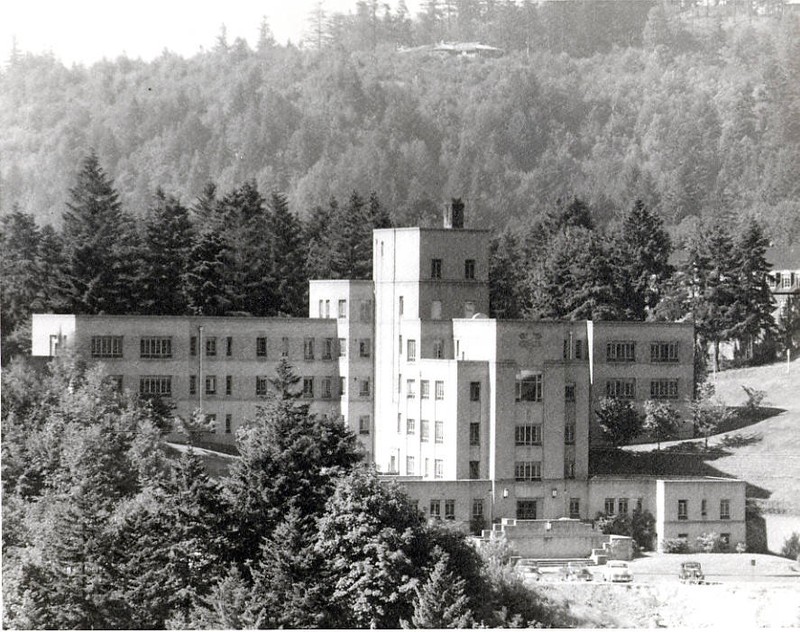
Construction of the University State Tuberculosis Hospital, 1930s.
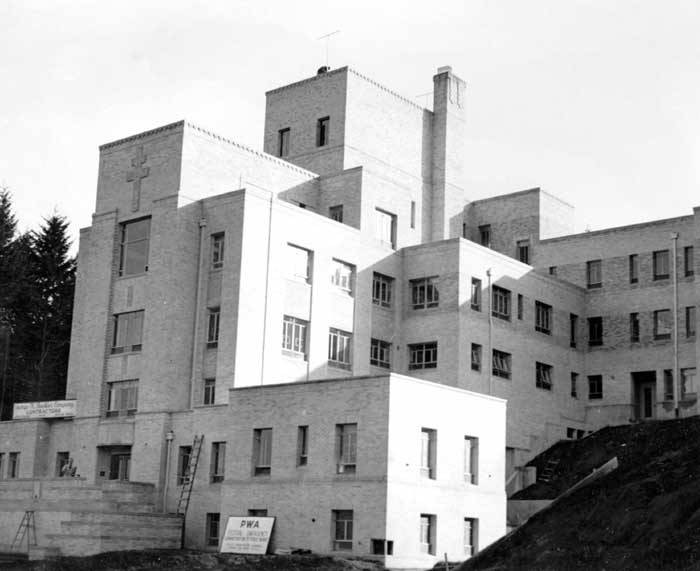
Artist's rendering of the University State Tuberculosis Hospital, circa 1930s.
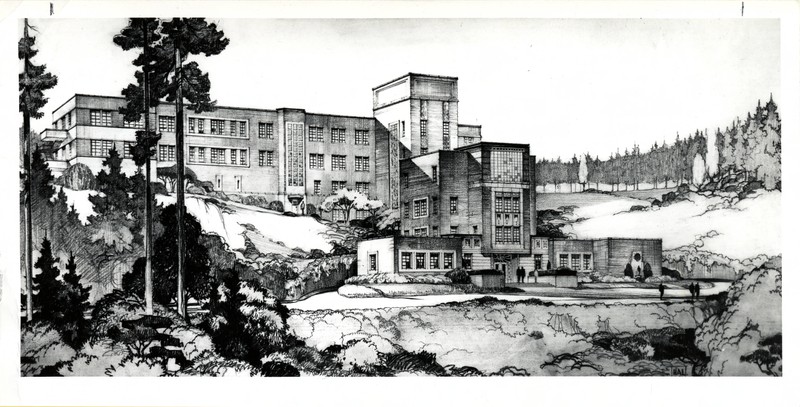
Admitting desk of the University State Tuberculosis Hospital, circa 1939.
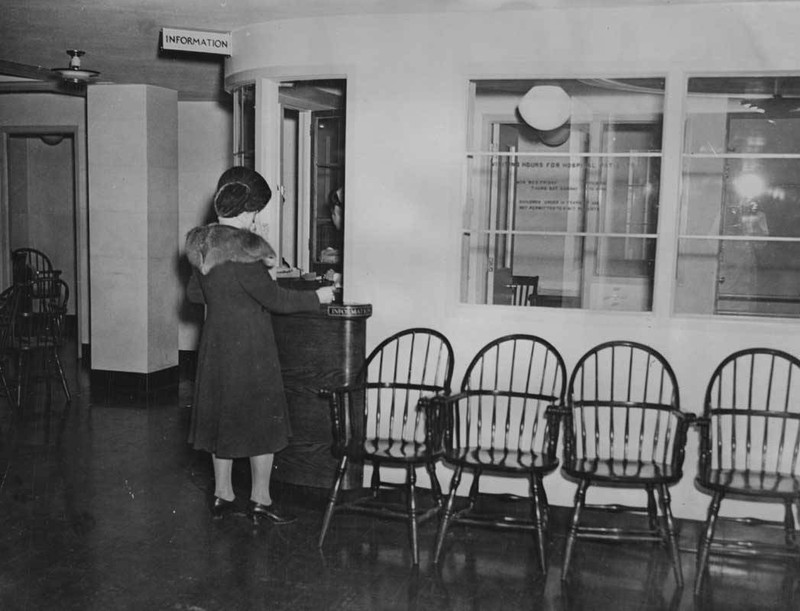
Aerial view of Marquam Hill showing the University State Tuberculosis Hospital (bottom center) with a wooden pedestrian bridge (left) leading to the hospital, 1940.
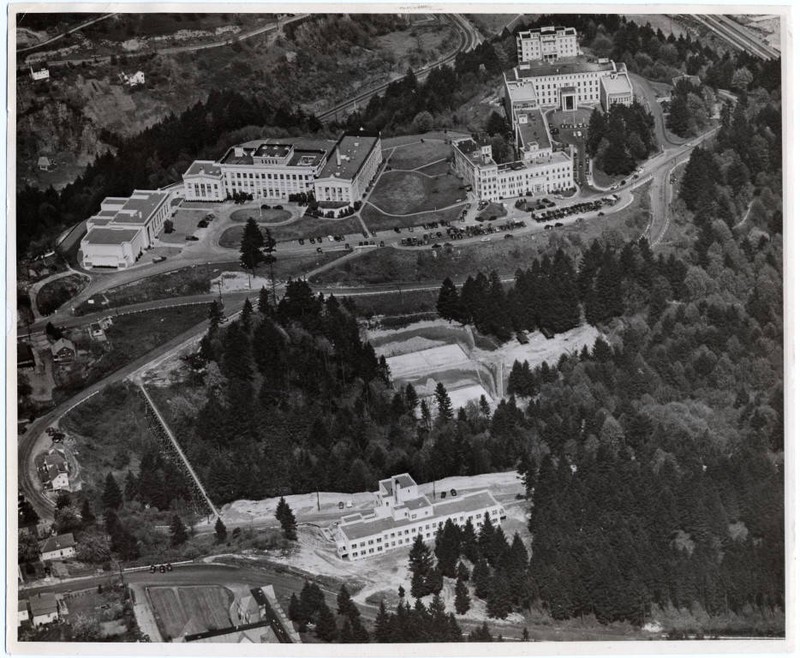
Backstory and Context
Text-to-speech Audio
The University State Tuberculosis Hospital, completed in 1939, served as the state’s primary tuberculosis hospital, provided valuable training in the case of this major disease, and participated in national programs to eradicate the disease. The 80-bed hospital relied on X-ray diagnosis, and treatments included surgery and light therapy. In 1944, streptomycin, the first drug found to be effective against tuberculosis, was introduced. Many University of Oregon Medical School nursing and medical students had clinical rotations in the hospital, crossing a wooden pedestrian bridge across the canyon between the university campus and the hospital.
In 1954 the newspapers reported that, for the first time since the University State Tuberculosis Hospital opened its doors in 1939, there was no waiting list for new cases. University of Oregon Medical School Dean, David E. Baird, said in a report to the State Board of Control, that the disappearance of the waiting list was due to several advances: the expansion of the Oregon State Tuberculosis Hospital in Salem, decreased periods of hospitalization thanks to the introduction of antibiotics such as streptomycin and viomycin, in combination with other medicines, and advances in surgical procedures. Early detection and isolation also reduced exposure for much of the uninfected population. However, this didn't mean that there were fewer tuberculosis cases reported; it simply meant that patients were being treated with less advanced stages of the disease, and as a result, hospital stays were shorter.
By the 1960s, with additional antibiotics and improved public health measures, extensive inpatient treatment at tuberculosis hospitals was no longer in high demand. In 1963, the State Legislature combined the Oregon State Tuberculosis Hospital in Salem with the University State Tuberculosis Hospital. As a result, patients located in the University State Tuberculosis Hospital were transferred to Salem. The number of patients receiving in-hospital treatment continued to dwindle, however, and in 1967 the Legislature closed the Salem hospital for good, and moved the remaining 65 patients back to the then-vacant University Tuberculosis Hospital. At that point, the University facility became the last tuberculosis hospital in operation in Oregon. The hospital was closed permanently in 1973, with the patient population having dwindled to 13 individuals. The former University State Tuberculosis Hospital now serves as the Campus Services Building for OHSU.
Sources
Barber, Lawrence. "Victory over tuberculosis seen in closure of University State Tuberculosis Hospital." The Oregonian (Portland, OR), December 26, 1973: 39. NewsBank: Access World News – Historical and Current.
Housing the Victims of the Great White Plague: The Oregon State Tuberculosis Hospital. February 2005. Historical Collections & Archives, OHSU Library. https://www.ohsu.edu/historical-collections-archives/housing-victims-great-white-plague-oregon-state-tuberculosis.
What's Going On? At the University of Oregon Medical School, February 1963: 5-12. Archival Publications. Historical Collections & Archives, OHSU Library.
OHSU Digital Collections, https://doi.org/10.6083/M4J101QZ
OHSU Digital Collections, https://doi.org/10.6083/M4V1236M
OHSU Digital Collections, https://doi.org/10.6083/M49885JN
OHSU Digital Collections, ttps://doi.org/10.6083/M4222SBW
OHSU Digital Collections, https://doi.org/10.6083/M4HT2MTQ
